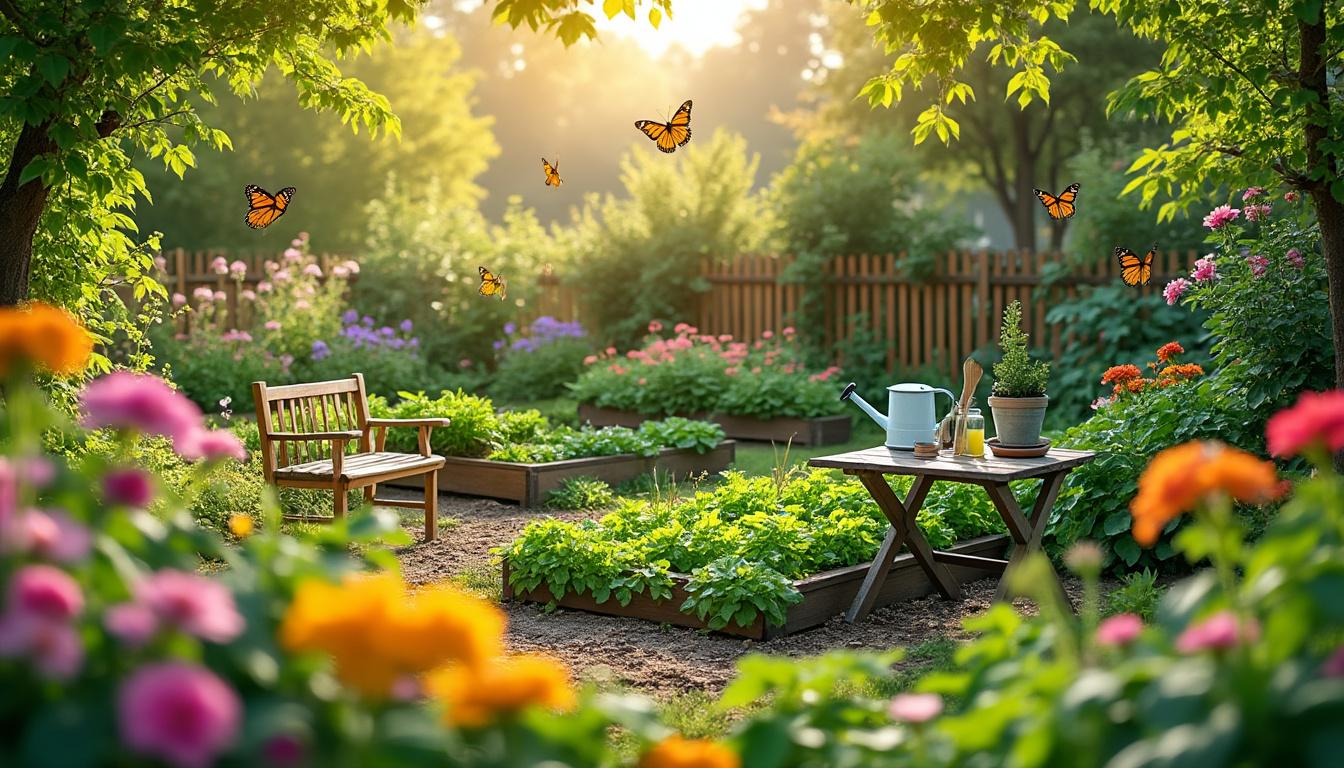Creating the ideal home garden demands a blend of knowledge, strategic planning, and the right products. Home gardening has witnessed a significant surge, especially following the COVID-19 home gardening trend, as individuals sought healthier lifestyles and more control over their food sources. This guide highlights essential tips that ensure a garden not only thrives but also becomes a sanctuary for relaxation and sustenance. With insights on soil preparation, plant selection, pest control, and garden maintenance, homeowners can optimize their gardening efforts effectively.
Optimizing Soil Preparation for a Healthy Garden Foundation
The foundation of any successful home garden lies in the quality and condition of its soil. Without proper soil preparation, even the finest plant varieties can fail to flourish. Understanding soil composition and how to amend it is critical to supporting plant health and maximizing yields.
Begin by performing a soil test to determine pH levels and nutrient content. Ideal pH for most garden plants ranges between 6.0 and 7.0, promoting nutrient availability. Depending on the test outcome, amendments such as lime (to raise pH) or sulfur (to lower pH) might be necessary.
Incorporating organic matter is a proven strategy to enhance soil structure, water retention, and microbial activity. Brands like Espoma offer organic soil conditioners that provide slow-release nutrients and improve soil vitality over time. Adding rich compost or well-aged manure integrates beneficial microbes and enhances aeration, essential for root development.
- Test soil pH and nutrient content annually.
- Amend soil with Espoma organic conditioners for sustained fertility.
- Incorporate compost and aged manure to improve soil texture and microbial life.
- Ensure proper drainage to avoid waterlogging, which can stress plants.
- Use mulch to conserve moisture and regulate soil temperature.
Well-prepared soil also acts as the first line of defense against pests and diseases by promoting robust plant growth. Avoid over-tilling, as it disrupts soil structure and beneficial organisms. Instead, employ no-till or minimal-till practices to maintain soil health and reduce erosion risks.
| Soil Amendment | Purpose | Recommended Application |
|---|---|---|
| Compost | Improves soil structure, adds nutrients | Apply 2-3 inches evenly and mix into top 6-8 inches of soil |
| Lime | Raises soil pH | Apply 5 pounds per 100 sq ft for acidic soils |
| Espoma Organic Fertilizer | Provides slow-release nutrients | Follow label instructions; generally 1-2 pounds per 100 sq ft |
| Mulch | Moisture retention, weed suppression | Apply 3 inches around plants without covering stems |
Strategic Plant Selection Tailored to Your Home Garden Environment
Choosing the right varieties of plants is essential for a flourishing garden that fits the home gardener’s climate, space, and aesthetic preferences. Leveraging reputable brands such as Burpee, Park Seed, and Proven Winners can simplify this process by providing superior seeds and plants bred for disease resistance and adaptability.
Consider native and climate-adapted plants first, as they typically require less maintenance and withstand local pests and weather extremes better. For vegetable gardens, select crops that complement the local growing season length and soil conditions. Root vegetables and leafy greens thrive in cooler weather, while tomatoes and peppers prefer warmer conditions.
- Use Burpee seeds for reliable vegetable varieties tailored to home gardens.
- Incorporate Proven Winners’ ornamental plants for extended bloom seasons and disease resistance.
- Start seeds indoors to extend growing seasons and ensure early harvests.
- Group plants by water and sunlight needs to simplify care and conserve resources.
- Incorporate companion planting to enhance growth and natural pest resistance.
Beyond functionality, plant selection also influences the overall design and ambiance. Incorporate a mix of flowering perennials, vibrant annuals, and edibles to create an appealing and productive garden. Always verify source trustworthiness to guarantee plant quality and clarity about plant traits, especially when using Park Seed or Scotts products.
| Plant Type | Recommended Brand | Key Benefit | Best For |
|---|---|---|---|
| Vegetables (Tomatoes, Peppers) | Burpee | Disease-resistant, high yield | Warm-season garden beds or containers |
| Flowering Perennials | Proven Winners | Extended bloom time, pest resistance | Decorative borders and pollinator attraction |
| Herbs (Basil, Rosemary) | Park Seed | High germination rate | Herb gardens or kitchen windowsills |
| Grass & Lawns | Scotts | Improved turf density and color | Open lawn spaces |
Effective Pest Control and Prevention Strategies For A Thriving Garden
Pest management remains a critical challenge in home gardening, but it can be addressed efficiently with knowledge and the right tools. Integrated pest management (IPM) practices combine mechanical, biological, and chemical controls to maintain healthy plants without excessive pesticide use.
Popular products like Miracle-Gro insecticides and Gardena pest control tools bring modern solutions to common garden pests including aphids, slugs, and beetles. Additionally, learning to recognize pest damage early enables prompt treatment, reducing losses.
- Regularly inspect plants for signs of pest activity or disease.
- Encourage beneficial insects such as ladybugs and lacewings which prey on harmful pests.
- Use physical barriers like row covers or netting to protect vulnerable crops.
- Apply targeted treatments with trusted products such as Miracle-Gro insect control.
- Implement cultural controls like crop rotation and proper sanitation to disrupt pest cycles.
Considering the rise in home gardening post-COVID-19, concerns about pests like ants and rats have increased. Accessing budget-friendly pest management tips can greatly assist gardeners. Strategies provided at keeping ants away or preventing rats in home gardens offer practical advice for maintaining pest-free gardens.
| Pest | Common Damages | Control Methods | Recommended Products |
|---|---|---|---|
| Aphids | Leaf curling, stunted growth | Introduce ladybugs, insecticidal soap | Miracle-Gro insecticide, Gardena sprayers |
| Slugs | Leaf holes, plant damage | Handpicking, barriers | Organic slug repellents |
| Ants | Protect aphids, disrupt soil | Use ant baits, eliminate nests | Check budget tips here |
| Rats | Root damage, fruit theft | Trapping, exclusion methods | See prevention advice here |
Efficient Watering Techniques To Boost Garden Productivity
Water management greatly influences the health and productivity of a home garden. Overwatering or underwatering can stress plants, reduce yield, and increase susceptibility to pests and diseases. Utilizing advanced irrigation tools and mastering watering schedules ensures plants receive optimal hydration.
The Gardena brand offers an impressive lineup of smart watering systems, including drip irrigation and timer-controlled sprinklers. These systems deliver consistent moisture while conserving water, an important consideration in sustainable gardening and in areas facing drought conditions.
- Schedule watering in early mornings or late evenings to minimize evaporation.
- Use Gardena drip irrigation to target the root zone directly and avoid wetting foliage.
- Monitor soil moisture regularly to adjust watering frequency appropriately.
- Mulch garden beds to retain moisture and reduce watering needs.
- Consider Sierra Stealth moisture sensors to automate irrigation based on real-time soil data.
Proper watering also fortifies plants against stresses such as heatwaves or disease outbreaks. Pairing efficient irrigation with drought-tolerant plant varieties further enhances garden resilience.
| Watering Method | Application | Benefits | Recommended Tools |
|---|---|---|---|
| Drip Irrigation | Targeted root watering | Water conservation, reduced disease risk | Gardena drip systems |
| Hand Watering | Small beds and container plants | Control over water quantity | Fiskars watering wands |
| Automated Timers | Scheduled irrigation | Consistent moisture levels | Gardena timers |
| Soil Moisture Sensors | Real-time moisture monitoring | Precision watering, water savings | Sierra Stealth sensors |
Seasonal Garden Maintenance And Expansion For Long-Term Success
Sustaining an ideal home garden requires ongoing attention and adjustment through the seasons. Seasonal tasks include pruning, soil amendment, planting rotations, and pest inspections that align with plant growth cycles. These practices support continual productivity and landscaping appeal.
As spring arrives, focus on soil aeration, fertilization with products like Miracle-Gro, and transplanting young seedlings. Summer demands vigilant irrigation management and pest control to protect plants under heat stress. In autumn, gardeners should clear debris, mulch beds, and plant cover crops to replenish soil health during winter dormancy.
- Prune dead or diseased branches to promote healthy growth.
- Rotate crops annually to break pest and disease cycles.
- Use Scotts lawn care products for maintaining lush greenery around garden beds.
- Expand garden beds gradually using Park Seed additions for diversity.
- Monitor weather forecasts and adjust watering accordingly.
Seasonal planting shows particular importance in extending harvests and improving garden aesthetics. Leveraging regional events such as the Central Ohio Home Garden Show or Southern Home Garden Show can introduce innovative techniques and plant varieties to homeowners.
| Season | Key Tasks | Recommended Products | Benefits |
|---|---|---|---|
| Spring | Soil preparation, fertilizing, transplanting | Miracle-Gro, Espoma fertilizers | Kickstarts plant growth, improves yields |
| Summer | Irrigation management, pest control | Gardena watering systems, Miracle-Gro insecticides | Protects plants from heat stress and pests |
| Autumn | Mulching, debris clearing, cover cropping | Espoma soil conditioners | Prepares soil for winter, prevents erosion |
| Winter | Tool maintenance, garden planning | Fiskars pruning tools | Ensures readiness for the next season |
Frequently Asked Questions (FAQ) About Creating The Perfect Home Garden
Q1: How often should soil be tested for optimal garden health?
Soil should be tested at least once a year before the planting season to evaluate pH and nutrient levels. This allows for precise amendments that improve growth conditions.
Q2: What are the benefits of using organic fertilizers like Espoma?
Organic fertilizers provide slow-release nutrients that nourish plants without harmful chemicals, promoting healthier soil ecosystems and sustainable gardening.
Q3: How can I effectively manage pests without heavy pesticide use?
Integrated pest management strategies including encouraging beneficial insects, using physical barriers, and applying targeted organic treatments help control pests while minimizing environmental impact.
Q4: What’s the best watering method for a small home garden?
For small gardens, drip irrigation combined with hand watering is ideal, offering precise moisture control and reducing water waste.
Q5: How can seasonal garden maintenance enhance productivity?
Aligning maintenance tasks with seasonal plant cycles supports sustained growth, pest prevention, and soil health, leading to consistent yields and a vibrant garden year-round.

